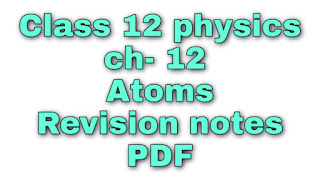ATOMS class 12 physics ch 12 revision notes pdf, class 12 physics chapetr 12 ATOMS revision notes pdf file by blue sky .
Youtube video-watch video
PDF FILE- Download pdf
in this video we cover all the topics ----- what is atom? Thomson atomic model of atom failure of Thomson atomic model Rutherford alpha particles scattering experiment it's observations distance of closest approach impact parameter results of Rutherford's alpha particles scattering experiment. cause of failure of Thomson and Rutherford model. Bohr atomic model postulate of Bohr atomic model mathematical analysis of Bohr atomic model spectrum of hydrogen atom lymon series balmer's series parchen series bracket series pfund series excitation excitation energy excitation potential ionisation energy drawbacks of Bohr atomic model.


These are the revision notes .
Be humble be teachable and always keep learning.
Everything start with a dream.
Don't work hard work smart..
Please like and comment the video and subscribe the channel .Give us valuable suggestions and feedback in the comment section.
Thank you.
Blue sky.
Gk
Blue sky PCM
Youtube video-watch video
PDF FILE- Download pdf
in this video we cover all the topics ----- what is atom? Thomson atomic model of atom failure of Thomson atomic model Rutherford alpha particles scattering experiment it's observations distance of closest approach impact parameter results of Rutherford's alpha particles scattering experiment. cause of failure of Thomson and Rutherford model. Bohr atomic model postulate of Bohr atomic model mathematical analysis of Bohr atomic model spectrum of hydrogen atom lymon series balmer's series parchen series bracket series pfund series excitation excitation energy excitation potential ionisation energy drawbacks of Bohr atomic model.
Introduction to the Bohr Model
Bohr model of the atom was proposed by Neil Bohr in 1915. It came into existence with the modification of Rutherford’s model of an atom. Rutherford’s model introduced the nuclear model of an atom, in which he explained that a nucleus (positively charged) is surrounded by negatively charged electrons.
Bohr modified this atomic structure model by explaining that electrons move in fixed orbital’s (shells) and not anywhere in between and he also explained that each orbit (shell) has a fixed energy level. Rutherford basically explained the nucleus of an atom and Bohr modified that model into electrons and their energy levels.
Bohr’s model consists of a small nucleus (positively charged) surrounded by negative electrons moving around the nucleus in orbits. Bohr found that an electron located away from the nucleus has more energy, and electrons close to the nucleus have less energy.
Postulates of Bohr’s Model of an Atom
- In an atom, electrons (negatively charged) revolve around the positively charged nucleus in a definite circular path called as orbits or shells.
- Each orbit or shell has a fixed energy and these circular orbits are known as orbital shells.
- The energy levels are represented by an integer (n=1, 2, 3…) known as the quantum number. This range of quantum number starts from nucleus side with n=1 having the lowest energy level. The orbits n=1, 2, 3, 4… are assigned as K, L, M, N…. shells and when an electron attains the lowest energy level it is said to be in the ground state.
- The electrons in an atom move from a lower energy level to a higher energy level by gaining the required energy and an electron moves from a higher energy level to lower energy level by losing energy.
Limitations of Bohr’s Model of an Atom
- Bohr’s model of an atom failed to explain the Zeeman Effect (effect of magnetic field on the spectra of atoms).
- It also failed to explain the Stark effect (effect of electric field on the spectra of atoms)
- It could not explain the spectra obtained from larger atom
In 1911, Ernst Rutherford suggested some experiments to H. Geiger and E. Marsden.
Both scientists performed an experiment whose schematic diagram is shown in the figure given above.
They directed a beam of 5.5 MeV α-particles emitted from a 214Bi83 radioactive source at a thin metallic foil (made of gold).
The beam was allowed to fall on a thin foil of gold of thickness 2.1 × 10‒7 m.
The scattered alpha-particles were observed through a rotatable detector consisting of zinc sulphide screen and a microscope. The scattered alpha-particles on striking the screen produced brief light flashes or scintillations. These flashes may be viewed through a microscope and the distribution of the number of scattered particles may be studied as a function of angle of scattering.
Velocity of Electron in Bohr’s Stationary Orbits
The velocity is given by,

This meansv∝ (1/n).
Total Energy of Electron in Bohr’s Stationary Orbits
Total energy is given by,

The negative sign of the total energy of an electron moving in an orbit means that the electron is bound with the nucleus. Energy will thus be required to remove the electron from the hydrogen atom to a distance infinitely far away from its nucleus (or proton in hydrogen atom).
Note: Bohr model is valid for only one-electron atoms/ions; an energy value, assigned to each orbit, depends on the principal quantum numbernin this model.We know that energy associated with a stationary state of an electron depends onnonly, for one-electron atoms/ions. For a multi-electron atom/ion, this is not valid.
Energy levels of Hydrogen Atom
The total energy of an electron innth orbit of a hydrogen atom is given byEn= (‒13.6/n2) eV.
Puttingn= 1, 2, 3… is above equation, we get the energies of electron as,E1 = ‒ 13.6 eV,E2 = ‒ 3.4 eV,E3 = ‒1.51 eV…

Comments
Post a Comment